How To Train A Deaf Dog & Help Them Live Their Best Life
Got a senior dog at home - or one that's been born hard of hearing? Wondering how to train a deaf dog by yourself? Here's how to get started - and set them up for a lifetime of success.
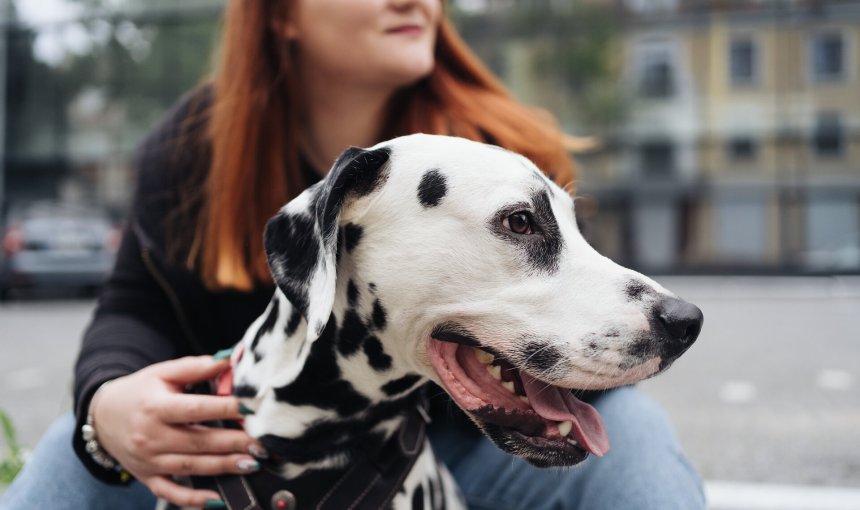
Whether it’s because they’re getting a bit whiter around the whiskers or it’s something they’ve been born with – living with a deaf dog can be an adventure of its own. But the first thing to keep in mind: your buddy might not be able to respond to your voice like others. Which might make you might be wondering: how to train a deaf dog? Especially to come back when called if we’re both outdoors together…and they want to explore?
Well, as it turns out, deaf dogs – just like hearing dogs – are loving, intelligent, and capable of learning a whole bunch of commands and tricks. With patience, consistency, and a little emergency planning for your outdoor adventures, you can train your buddy to understand and respond to your cues – and live a long, happy, fulfilling life by your side.

Find out how your dog spends their time.
Read moreHow to tell if your dog is deaf
Whether you’ve adopted a deaf puppy or you’re concerned your senior dog is getting hard of hearing, it’s still important to train them on the regular. (Your puppy will learn to control their impulses and behave, while your senior dog will benefit tremendously from the activity and quality time with you.)
- Most importantly, all dogs need to learn some way to come back to you when called – especially if you’re both outdoors.
- And in the case of a dog that can’t hear you call for them, it’s even more crucial to figure out ways to attract their attention and get them back to you.
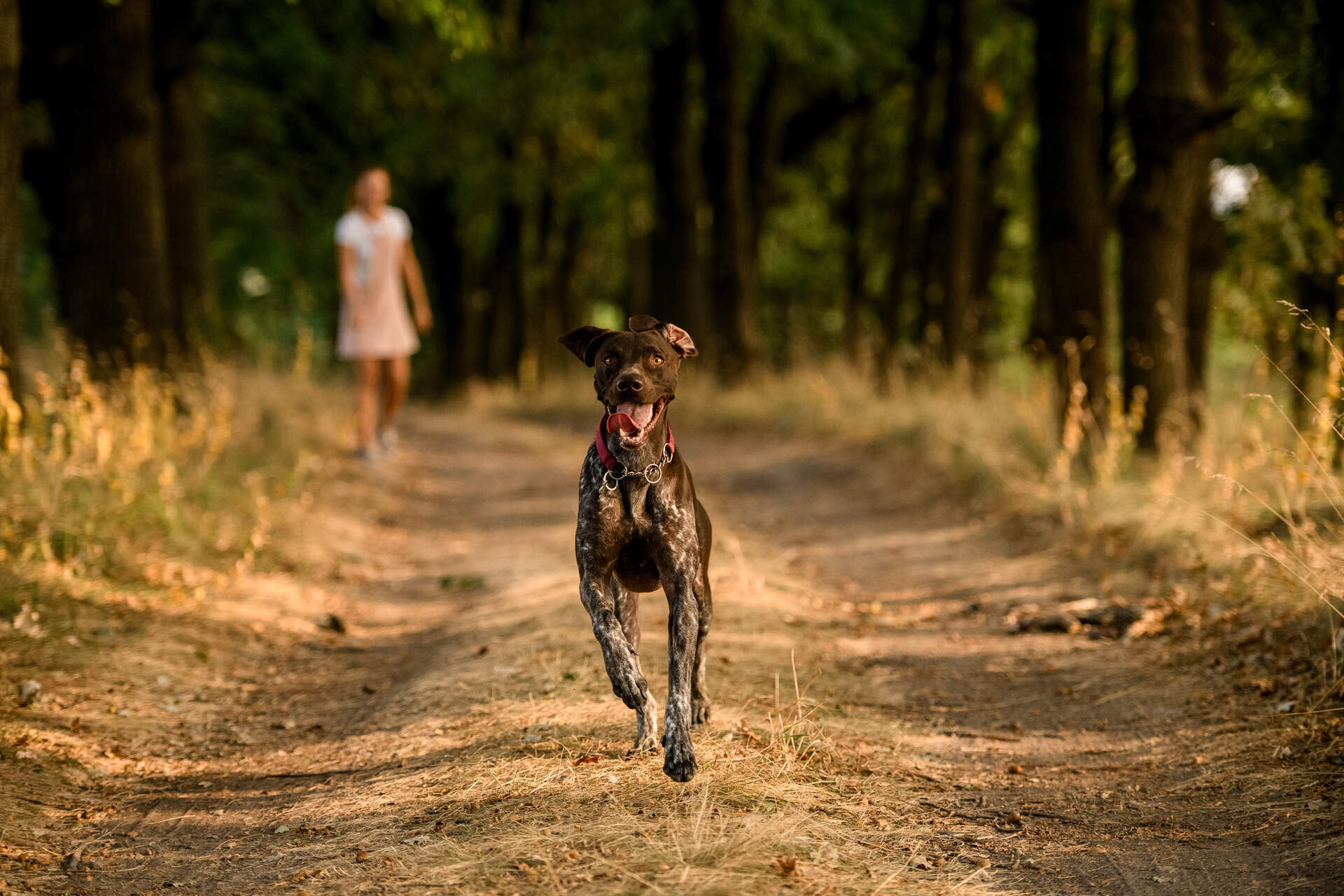
So here are a couple of ways to tell if your dog is hard of hearing – or experiencing gradual hearing loss as they grow older:
- They don’t respond to most sounds. Especially sounds that dogs normally might (or which they used to) – like their name, the doorbell, squeaky toys, or even cars outside. According to experts, hearing loss in dogs might begin with not being able to hear high-pitched sounds (like whistles) and then progress to others.1
- They seem less obedient or responsive to training. If you’ve got a senior dog you’ve had for many years and have been regularly training, there may suddenly no longer follow training commands.
- They startle easily. Your dog might spook more than usual because they don’t hear you (or others) approaching.
- They’re less active and/or sleep more, being harder to wake up or entice outdoors for walks and playtime.2
Your vet can help by performing some diagnostic tests to confirm whether your dog is experiencing hearing loss – and what steps you can take in advance to be better prepared.

💡Plus, before you head to your vet, you could always go better prepared – with your buddy’s actionable activity and sleep data. (Without losing a wink of yours.)
A deaf dog might sleep more – and more soundly, and you might find it more difficult to wake them up.
So monitoring how well they’re sleeping can help you:
- Pick up quicker on any progressive hearing loss,
- Take action quicker by getting your dog to a vet before it gets worse.
Sounds easier said than done though, right? After all, it’s not like you can hover over your sleeping dog 24/7 jotting down every little twitch, snore, or wake-up. Meaning you might be less likely to describe any changes in their sleep patterns accurately to your vet.
It’s why dog parents around the world – just like you – are investing in the actionable data you’d get from a Sleep Tracker built for dogs instead.
Meaning with just a glance at your phone, your trusty Tractive device can help you figure out:
- How long – and well – your dog sleeps on the regular
- Whether they’ve been waking up more often than usual (which could even signal cognitive decline as they grow older)
- If there’s been a sudden or gradual drop in their sleep quality over time
All of which can help you have a more productive conversation with your vet – and save a ton of money from unexpected (and thoroughly avoidable) medical bills.
Get Sleep Tracking With Tractive
How to train a deaf dog 101: Getting started
It might seem unlikely, but training a deaf dog isn’t too different from training any other dog – regardless of their hearing! Rather, they rely on their other senses, including their vision, smell, and touch to figure out what you’re expecting of them.
Just make sure that everyone in your household is consistent as well – using the same cues or hand signals as you. (You could even hang up a poster to help everyone remember.) This can help create a stable, consistent environment at home for your dog and get them learning and responding even quicker and better.

First, get your dog’s attention – without startling them
Deaf dogs can be easily startled – since they can’t hear your or others approaching. Which is why experts actually recommend you help your dog get used to being touched unexpectedly.3
Why? Because when your voice isn’t an option, touching them gently on the side or shoulder can help attract your dog’s attention when you need them to do something. And once you teach them to pay attention to you, you can move to other basic dog commands.
If you want to attract your dog’s attention, you could also:
- Walk into their line of sight.
- Very lightly stomp your feet – so that they feel the vibrations on the floor. (But not too hard, else you might frighten them.)
- Use a flashlight – or turn the lights of the room on and off.
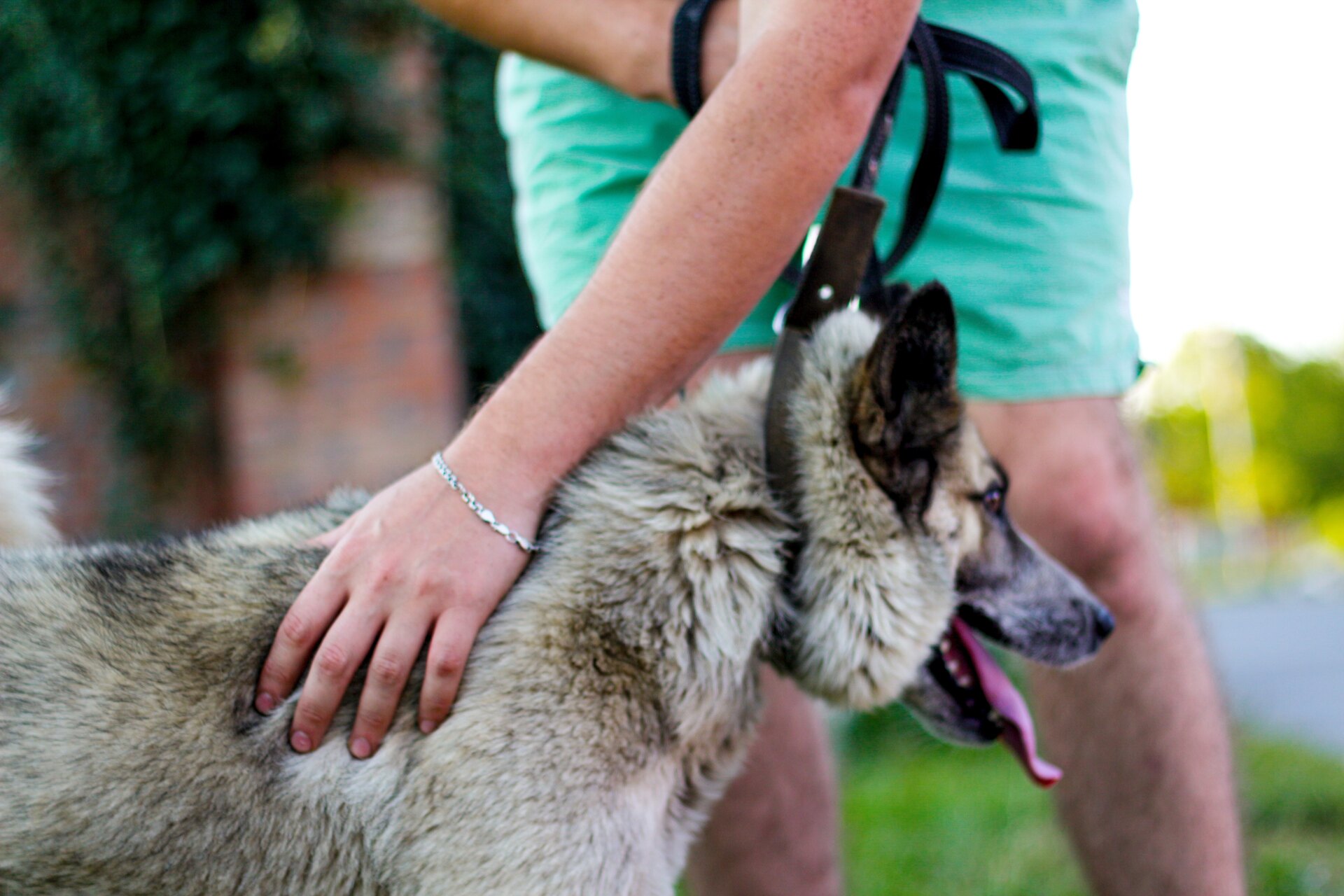
And here’s how to put this physical cue into action:
- Very gently touch your dog somewhere on their shoulder – when they’re relaxed, but facing away from you. Avoid touching their head or somewhere “sensitive.”
- When your dog turns around, give them a big smile and a treat. (Yes, your dog can tell how you’re feeling from your expressions and mannerisms, even if they can’t hear your voice.)
- Rinse, repeat, and practice – these steps will help your dog begin to associate an unexpected touch with a reward. So they’ll be less likely to startle.
How to train a deaf dog to “Watch” you
Once you’ve picked up how to get your deaf dog’s attention, it’s important to teach them how to maintain it – especially if you’re both in an environment with a few distractions.
Which is where it helps to teach them the “Watch me” command, to keep their attention. Like so:
- Hold a treat or a chew toy in your hands within your dog’s line of sight – your buddy will follow it with their eyes naturally.
- The minute your dog stops looking at the treat and at you instead, give them a thumbs up signal. (Communicating, “Good!”)
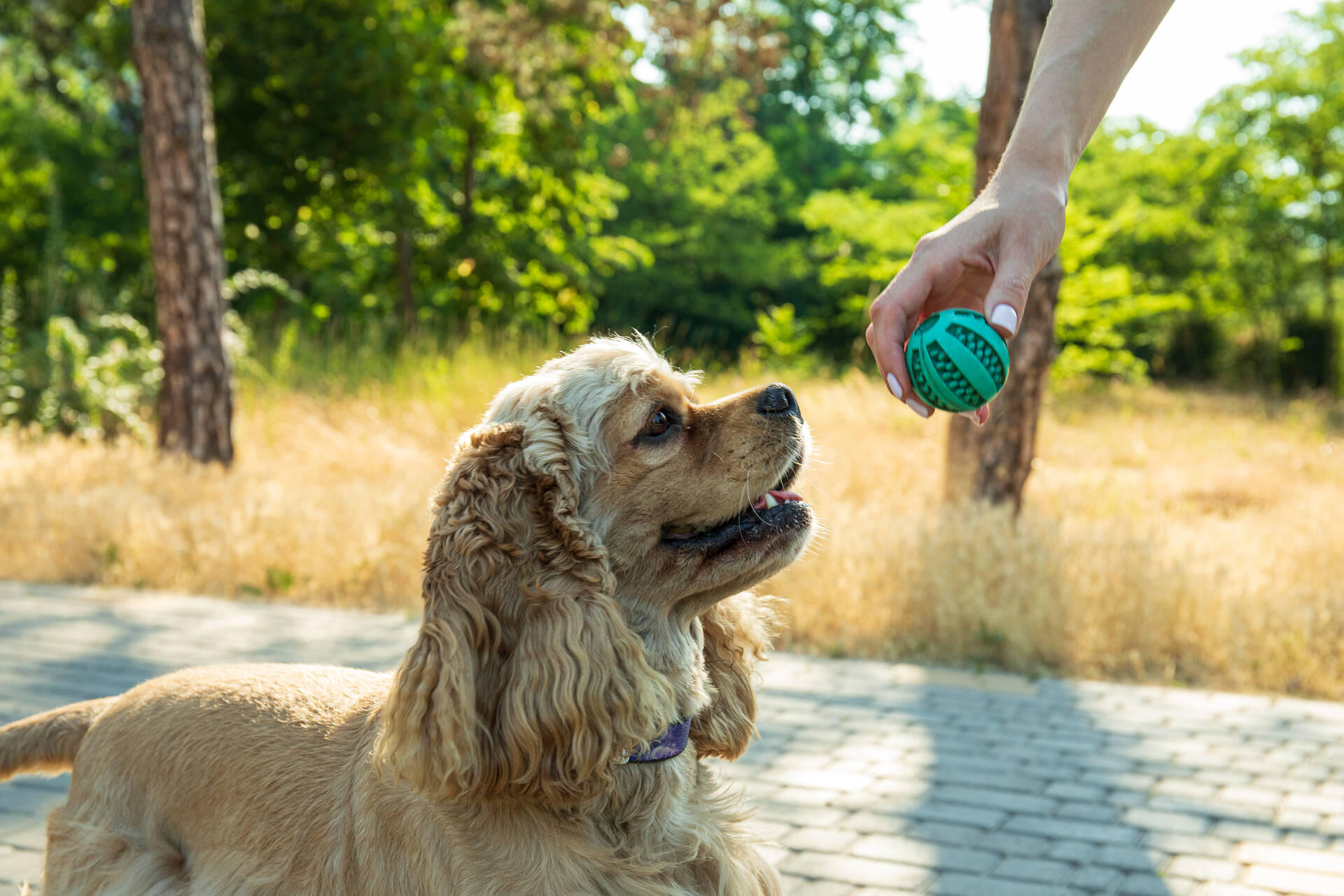
- Hand them the treat after.
- Gradually increase the length of time your buddy keeps looking at you before you give them the treat.
- If your dog breaks eye contact, repeat these steps – and practice plenty.
Next, teach your dog these basic commands
Now you might be wondering how to train a deaf dog commands like “Sit,” or “Stay,” without, well, saying these commands out loud. But with consistent hand signals, you can attract your dog’s attention and teach them that a specific hand signal = a command.
(And when they comply, that means a treat!)
Make sure to use some exaggerated movement at first – so your buddy gets used to them. (And then gradually reduce them over time.)
Besides, we’d also recommend you:
- Smile a ton and speak any praise out loud. Yes, it might seem counterintuitive to verbally praise a deaf dog, but it can help keep your body language positive. All of which can help positively reinforce any training commands.
- Always make sure your dog’s attention is on you first, so they’re less distracted.
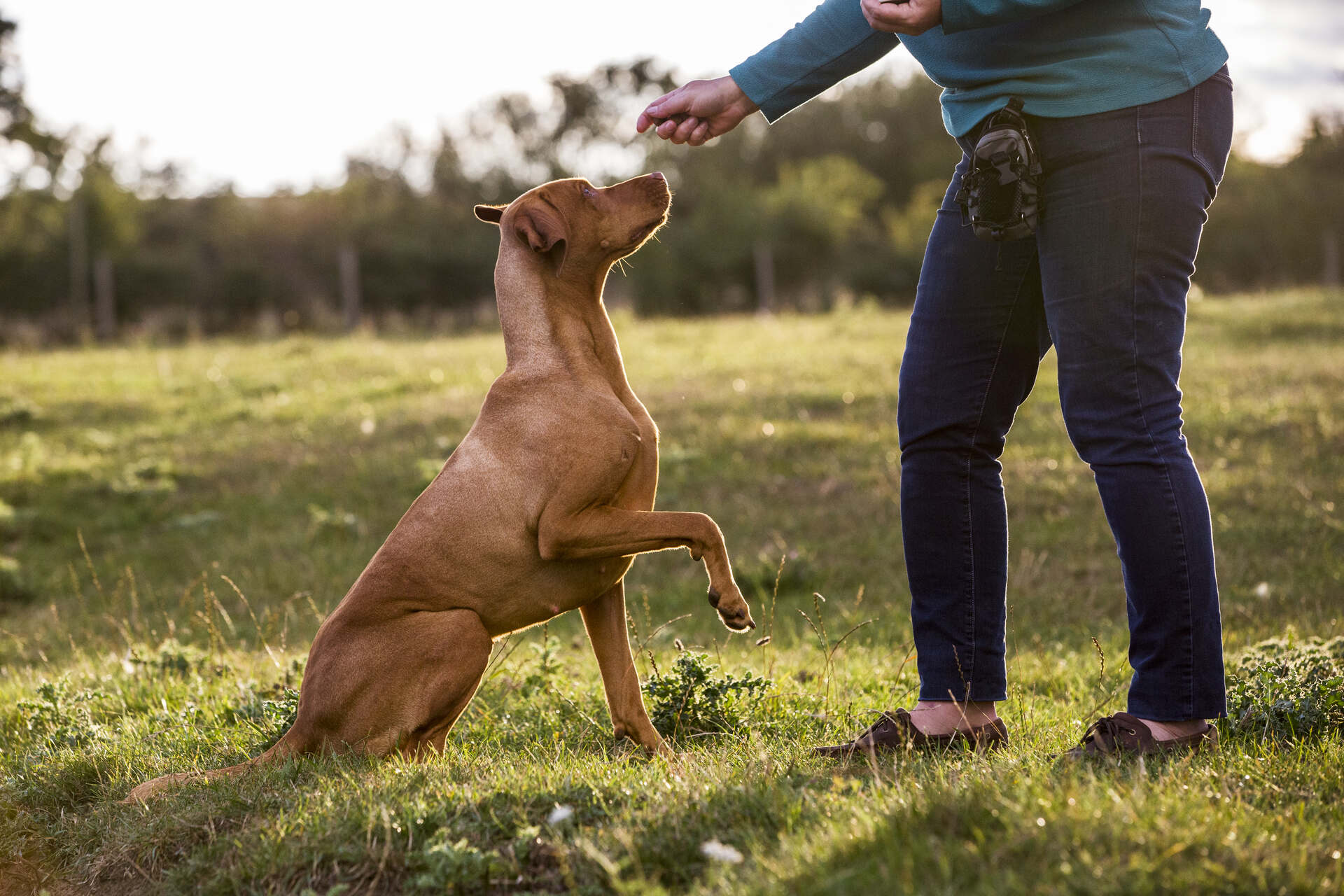
- Keep your training sessions short – 5-10 minutes, tops.
- Focus on one command at a time to avoid confusing your dog.
- Practice the same command several times before moving on to any other. Deaf dogs will need even more repetitions than hearing dogs, as well as even more consistent reinforcement.
With these points in mind, here’s how to train a deaf dog to…
“Sit“
Just like with hearing dogs, hold a treat above your dog’s nose and move it upwards. Your buddy will follow it with their nose – and end up “sitting” entirely by themselves.
- When they do, use a hand signal (e.g., your palm facing downward and moving in a “down” motion) to indicate “Sit.”
- Repeat this hand signal a few times to help your dog learn the connection between the hand signal and the behavior of sitting.
- When your dog does sit, give them a thumbs up – and a treat just a few seconds after.
Repeat these steps until your dog learns that “palm moving downwards = Sit.” With time, you can give them fewer and fewer treats until they learn to respond to the hand signal by themselves.
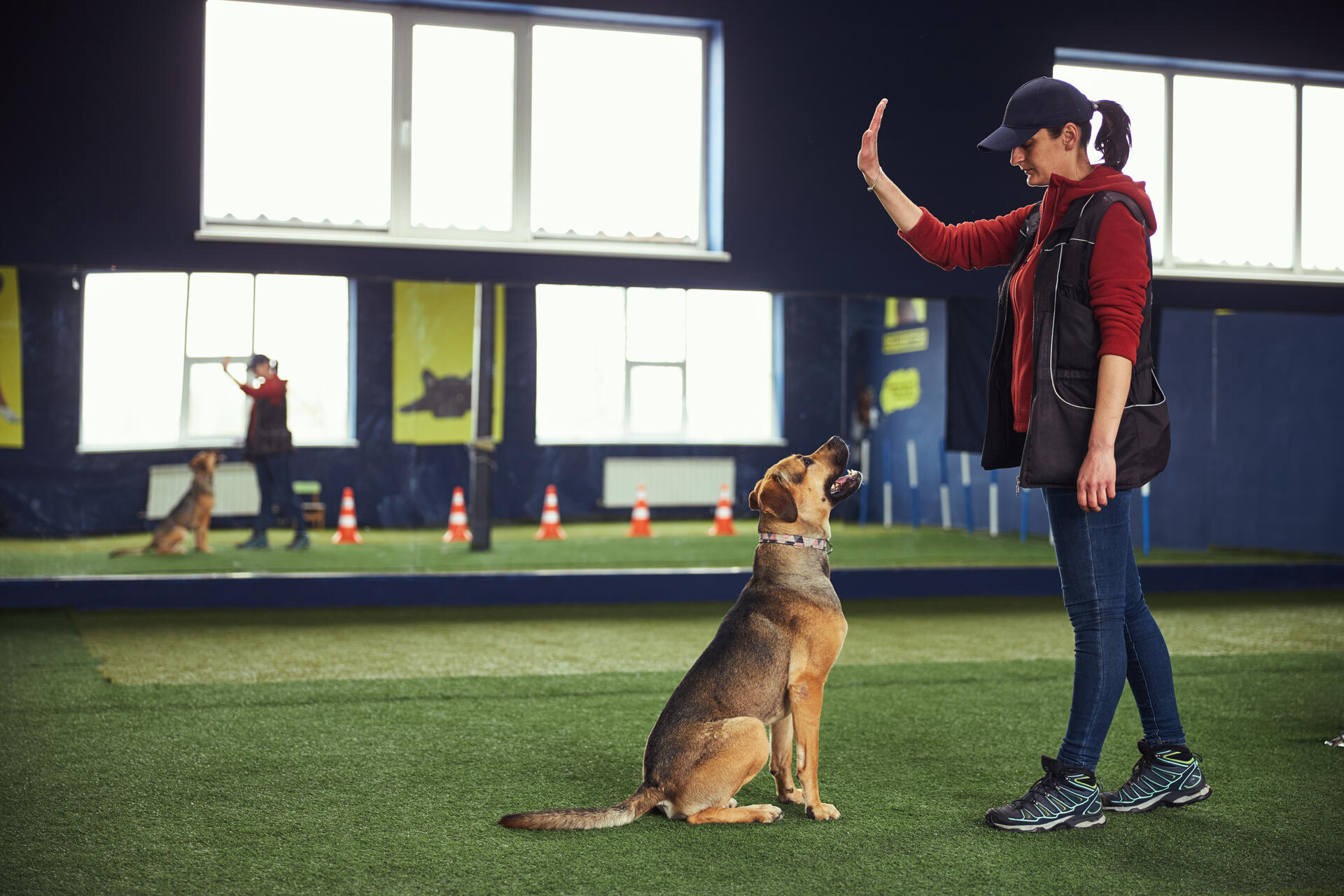
“Stay“
- Get your dog’s attention with a treat and a thumbs up once they’re in a “sitting” position.
- Use a hand signal like your open palm facing your dog – and then take a step back.
- If your dog remains in place, give them a thumbs up and a treat.
- If your dog follows you, get them to “Sit” again – and repeat the steps.
Gradually increase the distance and how long your dog should hold the “Stay” position.
“Quiet”
A common problem you might run into with deaf dogs is them barking a bit more or louder than other dogs. (Since they can’t hear their own noise – or out of frustration or anxiety.) All of which can make them a nuisance to your neighbors and certainly to other dogs and dog parents when you’re both out on walks together.
In this case, a hand signal indicating a “Shh!” motion (or a finger on your lips) can come in handy. Along with some toys or treats as distraction.
Now if, for example, you’ve got a dog barking out of frustration or boredom:
- Get their attention with a toy or a treat in their line of vision.
- Use the “Shh!” hand signal as you place the treat at your dog’s feet to distract them.
- As your dog bends over to eat the treat or play with the toy, they might stop barking.
- Give them a thumb up and a ton of pats once they’re quiet.
If your dog keeps barking, repeat the steps – and make sure they see you giving them a thumbs up when they do stop.
💡Ensuring your dog is well-exercised can prevent them from barking their heads off out of boredom, frustration, or anxiety. (Or even attention-seeking.)
And a great way to stay motivated to your buddy’s daily exercise routine?
- Setting them daily activity goals,
- and a little healthy competition with other dogs around you!
Both of which have never been easier to do, if you’ve invested in a Tractive device.
Because now, with just a glance at your phone, you can figure out:
- What’s a normal level of activity for your dog
- How many active minutes per day you can set them as a goal to hit
- How active your dog is compared to other, similar dogs around the world – with your very own community leaderboard.
All of which can motivate you to get your buddy out for more walks and playtime – keeping them healthy, preventing any boredom-related barking, and ranking on top of your leaderboard everyday!
“No“
Now in general, it’s better training dogs specific commands like “Drop it” or “Gentle” when you want them to do a specific action. But for a deaf dog, it might be better to teach them a general hand signal communicating “No!” instead.
Which could be something as simple as holding out an index finger and shaking it left to right. (Yes, you’ll feel a bit like a nursery school teacher. Yes, it’ll also prevent your dog from eating something potentially toxic from the sidewalk.)
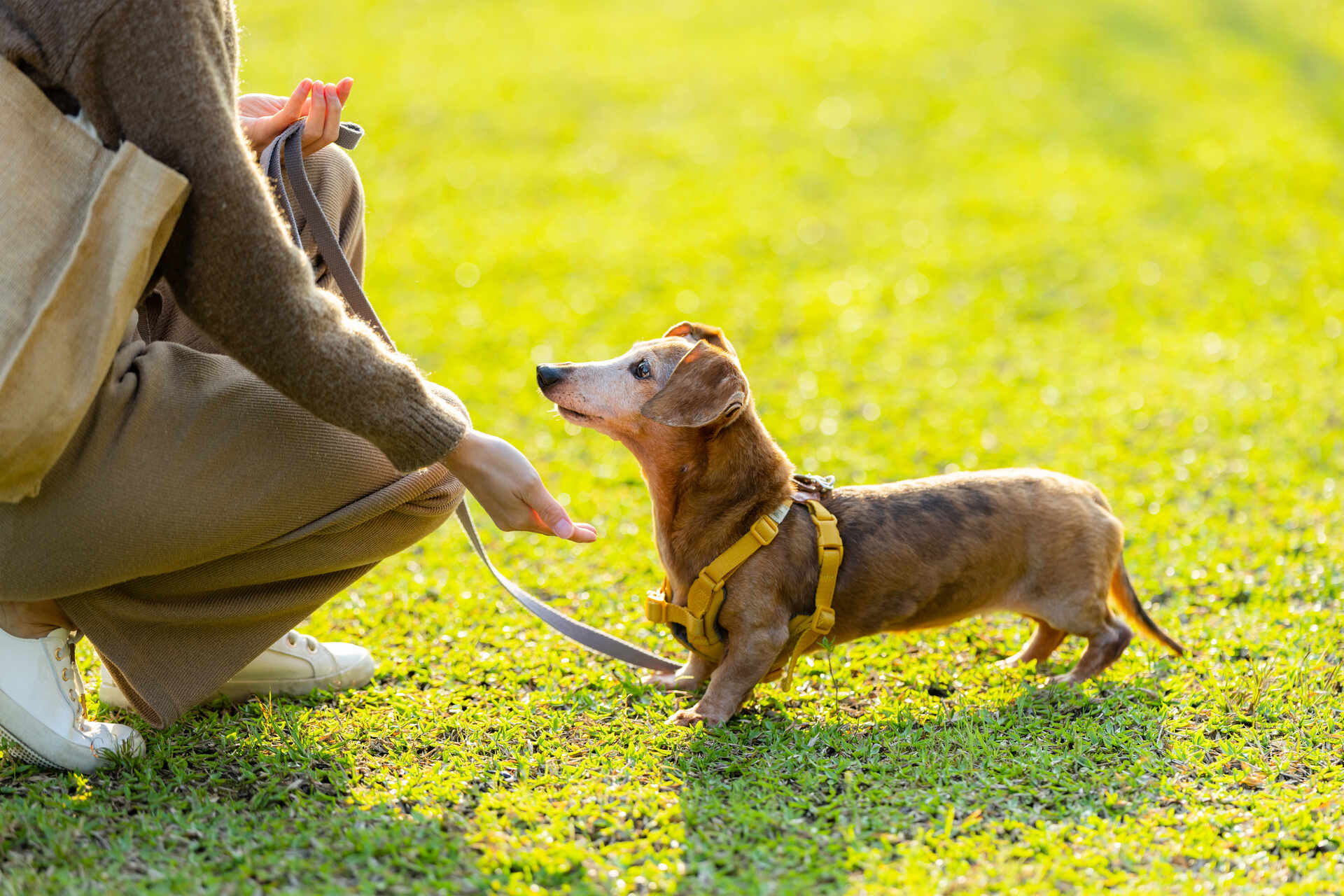
- Make sure your dog sees you shaking your head as you, say, remove a bit of food from their mouths or if they’re in the middle of roughhousing your slippers to death.
- Always pair the hand signal with removing the object (like food) or putting them for a few minutes in their crate or not letting them continue their activity. (Like chewing on your socks or being too rough with any guests that have arrived.)
- With time, this will help them learn that certain behaviors = “No!” = not being able to do something.
Now these basic commands work great for helping your dog manage the indoors. Using a thumbs up and a treat can also come in handy for:
- Potty training them, or when you reward them for relieving themselves in the correct spot
- Cleaning up after themselves or putting away their toys after playtime
- Getting along with other pets and people – without getting too rough or noisy
So now it’s time to figure out…
How to train a deaf dog to survive the outdoors
In general, experts recommend keeping your dog close by when you’re outdoors – especially if they have difficulties hearing you.

“Never allow a deaf dog to be off-leash in an unfenced, open area. It is too easy for a deaf dog to get spooked or distracted and run into harm’s way.
Deaf dogs can wear a long line or drag line to have more freedom to explore while still saying safely within your view.”
– VCA Animal Hospitals2
So with that in mind, we’d recommend you:
Socialize your dog plenty
Even with their special needs, it’s still important to get your buddy used to hanging out with other pets, people, and in different places. Spending time in different environments helps your dog learn how to control their impulses and behave – helping them adjust better and reduce anxiety in new situations.
So with your buddy firmly leashed to your side, make sure to take them to:
- Dog parks and other community areas around you, where they can interact with other dogs and dog parents.
- Your wider neighborhood, where it’s always a good idea to become a familiar face among your neighbors – who can alert you if they see your buddy wandering around the neighborhood.
- The vet’s clinic, where you should ideally be taking your dog regularly for checkups.
- Dog-friendly cafes and restaurants, where they need to learn not to lunge at every plate they see!
- Public transport, where – besides a leash – your buddy might also need to be muzzled the entire time.
Read more: City Dogs: How To Raise A Street-Savvy Pack Of Your Own

💡Start slow and introduce your buddy to these new environments, bit by bit. Each one of these is a potential training opportunity for basic commands like “Sit,” “Stay,” and “Quiet”. So your dog learns to adjust and behave accordingly. (Especially in an environment full of distractions!)
Get your buddy used to some gentle handling
Deaf dogs tend to startle easier. That’s why it’s a good idea to get your buddy gradually desensitized to unexpected touch.
Why? Because eventually, they’re going to have to deal with “strangers” handling them. (Like veterinary staff or even your local dog grooming service). And they’ll have to do so without barking, biting, or even peeing themselves in fright!
So it’s wise to start with a simple, gentle grooming routine at home – brushing out your dog’s coat on the regular, for starters.
- Besides helping your buddy get used to it, regular brushing also helps prevent their fur from matting and tangling, all of which can attract pesky critters like ticks and mites.
- Gradually introduce your dog to grooming tools like nail clippers – and put them away immediately if your buddy spooks at the sight of them.
- Keep some treats around and make sure to reward your dog plenty when they do behave.
💡Stick around while your dog gets groomed or brushed by someone else (ideally someone they’re familiar with, at first). With time, they’ll learn that these experiences are neutral and non-threatening – even positive – and it won’t spook them as much when a “stranger” does them instead.
Train your dog to come back when called
We’ve covered the basic commands above – now it’s time to get more serious. Having a good recall (or coming back when called) can potentially save your dog’s life if they’ve run away from you outdoors. And towards:
- An open road full of cars,
- An overflowing garbage bin,
- After a woodland animal,
- …or just too far from safety
But how to train a deaf dog to come back when…well, they can’t hear you actually call out for them?
In these situations, you’ll have to be more vigilant than ever. Keep a firm hand on your buddy’s leash to prevent an escape.
But if they do:
- Get in their line of vision and wave to get their attention.
- Open out your arms and make yourself look as happy as possible to encourage your dog to come back to you.
- Otherwise, a hand signal like your open hand moving towards your chest can substitute for the “Come back,” command.
Make sure to practice in a safe, enclosed area where your dog isn’t likely to get distracted. (But gradually move towards an area that does have some distractions, for some better practice.)
⚠️Just be warned: if you’re training a deaf puppy or a younger, high-energy dog, an environment full of distractions means at least a few thousand reasons they might end up running away to explore or investigate.
And no matter how vigilant you are, there’ll always be that worst case scenario where your dog pulls against their leash – and is now bolting away after a squirrel or another dog, a mile a minute. Unable to hear you calling for them.
💡Luckily, we’ve got the solution for you. Just hit “LIVE” on your Tractive mobile app:
And within seconds, you’ll be following your running dog’s every step – as they make their every step.
Because with its GPS-powered capabilities, your trusty Tractive device help you track your dog:
- In real-time,
- Over an unlimited range,
- While on vacation – or 175 countries on a Premium subscription
Which, from our stories from happy dog parents around the world, has even helped rescue deaf dogs that have gone running off while outdoors.

Is a vibration collar ethical for training deaf dogs?
In general, vets discourage the use of electronic or shock collars that administer a shock to your dog to modify their behavior.
- There’s always the possibility you might administer a harsher shock than expected – which won’t address the underlying cause of the behavior.
- Rather, this will most likely only make your dog bark, bite, or grow more fearful and anxious out of stress.
Read more: Fearful Dog: Our Expert Reveals Everything You Need To Know About Fear In Dogs
But what about a vibration collar? (I.e., a training collar that administers a low-level vibration to modify a dog’s behavior.)
Turns out, vets recommend some more human alternatives instead:

Use caution when considering any kind of wearable electronic device. Many dogs find the vibration to be aversive and can become frightened.
It is almost always safer and more humane to keep deaf dogs safely fenced or leashed with a long line.
– VCA Animal Hospitals4
More ways to keep your deaf dog safe – at home & beyond
It’s painful to admit, but no amount of training can 100% override your dog’s fight or flight instincts in a pinch. So it makes sense to plan ahead for an emergency – aka, a “runaway dog” situation.
Which for deaf dogs isn’t altogether too different from hearing dogs. But keep in mind that in a physical search, calling out their name just won’t help.
So instead you should:
Ensure your buddy is easy to identify
With an ID tag and collar at the very minimum – but also a microchip, ideally. This way, your buddy has a permanent ID tag implanted into their shoulder blades, which a vet or shelter staff can scan to find your contact details. (And then contact you.)
With these identification details, you’re that much more likely to be reunited with your lost dog – and that much quicker.
⚠️The only downside: a microchip can’t actually track your dog’s location or help you take an active role in finding your dog. You’ll still be relying on strangers to take your dog to a vet or shelter – and then actually contact you to inform you they’ve found your dog.
Read more: Dog Tracker Chip: What Are Dog Microchips vs GPS Trackers?
Always supervise your dog in your backyard
With passing cars, people, and other dogs outside, there’s very little stopping your buddy from stepping or jumping over your fence – or digging under it. So it’ll go a long way if you invest in a securely-fenced yard and at least someone supervising your dog when playing or just spending time outdoors.
💡And if you can’t put up a physical fence – why not try a Virtual Fence for a change?
In under 5 minutes of setup time, you can draw a “safe zone” around your home or backyard via your Tractive mobile app – and get an escape alert if your buddy tries sneaking past it.
So you can intervene right away and escape-proof your home without having to invest in an expensive, cumbersome physical fence.
Warn other pet parents about danger zones on your walks together
Ideally, your neighborhood, walking paths, and other dog-friendly areas are safe. But there’s always the change you’ll spot some areas you’d rather not have your dog approach. Like those including:
- Plants poisonous to dogs, including mushrooms
- Poison bait
- Animal traps
- Wild animals
- And more
All of which you can actually report via your Tractive mobile app – and broadcast it to fellow pet parents in your area!
Helping you both keep your buddy safe – and also do your part as a responsible pet parent.
Ready to set your buddy for a long, happy, safe life by your side?
You wouldn’t be the first dog parent to wonder how to train a deaf dog to sit, stay, and come back when called – especially when their safety’s concerned. But with patience, consistency, and a ton of treats, you can learn to find it a highly rewarding, fulfilling experience and learn to enjoy your journey of learning and growing together.
Just make sure to:
- Keep in mind your dog’s tendency to startle – and get them used to being touched gently. (Especially in a safe, familiar environment.)
- Draw their attention by waving or using a toy or a treat. Reward them plenty for maintaining eye contact so they can follow your instructions after.
- In all cases, make sure to use consistent hand signals for commands like “Stay” or “Quiet.” When they do get the behavior right, give them a thumbs up and a treat a few seconds after.
- Socialize your dog plenty by taking them to different environments (besides your dog park – but also cafes and other places around town.) All of these areas can help them learn to adjust and behave, plus they’re all training opportunities for the basic commands.
- Always keep your dog firmly leashed by your side – and easy to identify in case they go missing.
And in the worst case scenario…
- Hit “LIVE” on your Tractive mobile app – and track your buddy’s movements in real-time if they bolt, spook, or just wander away too far from safety. (And where they can’t hear you calling out for them.)


Always know where your dog is
Follow every step in real-time with unlimited range. Get alerts if they wander too far. Keep them happy & healthy with Wellness Monitoring. And let others – like walkers or sitters – keep an eye on your dog too.
Still wondering how to train a deaf dog some basic tricks? Here’s a video to help you put these tips to action – featuring BB, a congenitally blind rescue Border Collie:
And if you’ve liked this post, share it with a friend or a loved one – and let’s help build a safer, kinder world for our furry friends together.




